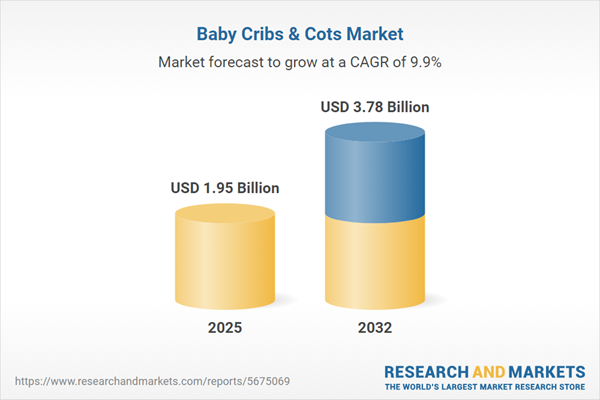Speak directly to the analyst to clarify any post sales queries you may have.
The baby cribs and cots market is undergoing considerable evolution, shaped by digitalization, demographic shifts, and tightening regulatory demands. For senior decision-makers, this dynamic environment demands strategic flexibility, operational efficiency, and ongoing innovation to remain competitive and meet modern consumer expectations.
Market Snapshot: Baby Cribs and Cots Market Growth Trajectory
The global baby cribs and cots market demonstrates stable, reliable growth, anchored by defined valuations and a clear compound annual growth rate. Sustained competition between established brands and new entrants is fostering both increased investment in regulatory compliance and the introduction of advanced safety features. Digital procurement platforms are increasingly integral, streamlining transactions for manufacturers, distributors, and suppliers, while enhancing responsiveness to changing buyer demands. The sector's competitive landscape is evolving as companies enhance user experience, commit to sustainability, and assimilate digital technologies, allowing organizations to align their offerings more closely with the unique needs of diverse regions.
Scope & Segmentation
- Product Types: Bassinets, convertible cribs, cradles, mini cribs, portable cribs, and standard cribs are tailored to serve differing consumer lifestyles, from compact urban spaces to larger family homes, ensuring product-market fit across customer segments.
- Material Types: Hardwoods, softwoods, aluminum, steel, polyethylene, and polypropylene offer a mix of durability, cost efficiency, and sustainability, which supports not only quality assurance but also informed sourcing and manufacturing decisions.
- Distribution Channels: Baby stores, supermarkets, specialty retailers, company-operated e-commerce, and prominent online marketplaces enable a comprehensive, multi-channel approach that optimizes reach to both established buyers and emerging parents entering the market.
- Regional Coverage: Americas, Europe, Middle East & Africa, and Asia-Pacific each offer unique challenges and opportunities, including differing consumer preferences, regulatory requirements, and competitive landscapes, guiding localized go-to-market and supply chain strategies.
- Key Companies: Dorel Industries Inc., Newell Brands Inc., Goodbaby International Holdings Limited, Artsana S.p.A., Stokke AS, BabyBjörn AB, Peg Perego S.p.A., Inglesina S.p.A., Mamas & Papas Ltd, and Evenflo Company, Inc. drive industry standards and pursue continuous advancements in material design and operational procedures.
This comprehensive segmentation framework enables leaders to streamline portfolios, efficiently manage compliance, and maintain flexibility in adapting product strategies to diverse regional and regulatory requirements.
Key Takeaways: Strategic Insights from the Baby Cribs and Cots Market
- Eco-conscious and modular designs support long-term sustainability targets while responding to consumers’ demand for adaptable solutions that suit differing family and housing needs.
- Smart technology integration and the adoption of robust, modern materials elevate product safety, deepen market compliance, and allow for smooth scalability into international markets.
- Close collaboration with regulatory authorities speeds the adoption of updated standards and serves as a catalyst for material and design-related innovation.
- Offering tailored product selections and deploying targeted marketing helps address evolving buyer demographics, strengthening brand differentiation.
- The strategic blend of integrated digital procurement tools and established sales networks enhances procurement efficiency and enables quick adaptation to fluctuations in market demand.
- Diversified sourcing and automation in operations bolster resilience, helping organizations navigate an ever-changing regulatory and competitive landscape.
Tariff Impact: Navigating Policy Shifts and Cost Structures
In anticipation of new United States tariffs scheduled for 2025, organizations are reassessing risk management protocols and advancing process automation to sustain uninterrupted business flows. Emphasis on near-shoring strategies and strengthening supplier alliances is proving critical in maintaining supply chain reliability and managing the transition through policy adjustments.
Methodology & Data Sources
The analysis is grounded in primary interviews with senior industry executives, material science specialists, and standards-certification consultants. Supporting insights are drawn from secondary research, providing additional context for strategic decisions in the baby cribs and cots market.
Why This Report Matters
- Connects innovation and responsible sourcing strategies to regulatory trends and the evolving requirements of modern buyers, ensuring organizations remain agile within the global market.
- Equips leadership with actionable guidance to reinforce multi-channel strategies and establish resilient, adaptive supply chains in volatile procurement conditions.
- Provides disciplined analysis across all segments and regions, helping strategy teams approach growth initiatives in key geographical areas with confidence.
Conclusion
Positioning for enduring value in the baby cribs and cots market rests on adaptive compliance, digital adoption, and robust operations. With these insights, senior leaders can proactively direct their teams through evolving market pressures.
Additional Product Information:
- Purchase of this report includes 1 year online access with quarterly updates.
- This report can be updated on request. Please contact our Customer Experience team using the Ask a Question widget on our website.
Table of Contents
3. Executive Summary
4. Market Overview
7. Cumulative Impact of Artificial Intelligence 2025
Companies Mentioned
The companies profiled in this Baby Cribs & Cots market report include:- Dorel Industries Inc.
- Newell Brands Inc.
- Goodbaby International Holdings Limited
- Artsana S.p.A.
- Stokke AS
- BabyBjörn AB
- Peg Perego S.p.A.
- Inglesina S.p.A.
- Mamas & Papas Ltd
- Evenflo Company, Inc.
Table Information
| Report Attribute | Details |
|---|---|
| No. of Pages | 184 |
| Published | November 2025 |
| Forecast Period | 2025 - 2032 |
| Estimated Market Value ( USD | $ 1.95 Billion |
| Forecasted Market Value ( USD | $ 3.78 Billion |
| Compound Annual Growth Rate | 9.9% |
| Regions Covered | Global |
| No. of Companies Mentioned | 11 |









